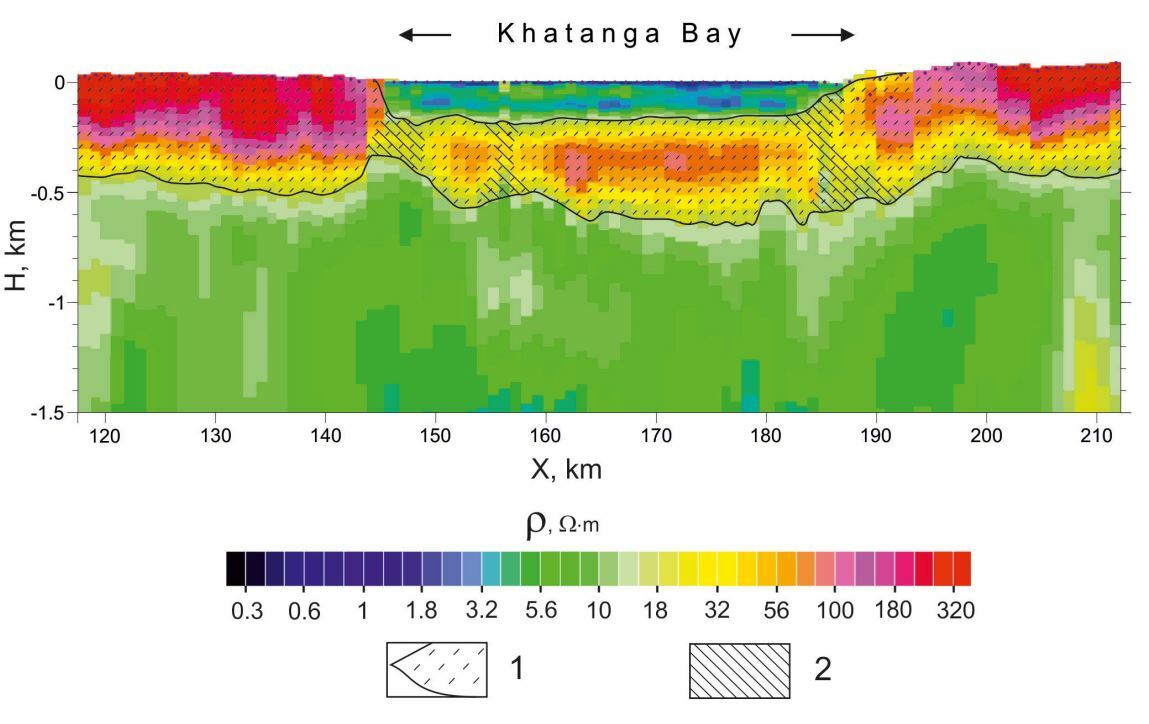Hydrogeology & Geocryology
Water is the main agent of the electric current conduction in the ground, therefore the electromagnetic (EM) geophysical methods could be very helpful in hydgrogeological and geocryological applications, being particularly sesensitive to such parameters as the water content, water salinity, its temperature and physical state. The magnetotellurics (MT) has the largest investigation depth among all other EM geophysical methods and thus is perfectly suitable for exploration of deep water aquifers and thick permafrost.
Permafrost studies in the Northern Russia
As an example of the permafrost exploration we consider an MT survey in the Khatanga Bay area, Taymyr, Russia, where a large amount of MT data have been collected by Nord-West Ltd., with some of the survey lines directly crossing the bay (measurements taken from the ice during the spring season). As can be seen from the image, in its onshore part, the icebonded permafrost has a thickness of about 500 m and resistivity between 50 and 500 Ωm. Closer to the coastline, there are conductive regions, supposedly associated with through taliks of 1–20 Ωm. In the upper part of the section, right beneath the Khatanga Bay, a thawed rocks layer is identifid with a thickness of about 200 m and resistivity of less than 10 Ωm. The frozen layer beneath the bay is manifested by lower resistivity (30–100 Ωm) compared to that in its onshore part, which is apparently due to the presence of enhanced bottom temperatures and, probably, increased salinity of pore fluids determining the existence of thawed interbeds inside this layer [Piskunova et al., 2018].
As an example of the permafrost exploration we consider an MT survey in the Khatanga Bay area, Taymyr, Russia, where a large amount of MT data have been collected by Nord-West Ltd., with some of the survey lines directly crossing the bay (measurements taken from the ice during the spring season). As can be seen from the image, in its onshore part, the icebonded permafrost has a thickness of about 500 m and resistivity between 50 and 500 Ωm. Closer to the coastline, there are conductive regions, supposedly associated with through taliks of 1–20 Ωm. In the upper part of the section, right beneath the Khatanga Bay, a thawed rocks layer is identifid with a thickness of about 200 m and resistivity of less than 10 Ωm. The frozen layer beneath the bay is manifested by lower resistivity (30–100 Ωm) compared to that in its onshore part, which is apparently due to the presence of enhanced bottom temperatures and, probably, increased salinity of pore fluids determining the existence of thawed interbeds inside this layer [Piskunova et al., 2018].

Resistivity image across the Khatanga Bay, Russia. X is the distance along profie, H is depth. Electrical resistivity values are shown as a color plot, with the color scale shown in the bottom of the fiure.
Explanation: 1 – ice-bonded permafrost, 2 – taliks. (after Piskunova et al., 2018)
Explanation: 1 – ice-bonded permafrost, 2 – taliks. (after Piskunova et al., 2018)
Exploration of deep aquifers in Zagros, Iran
The lack of fresh water is one of the most acute socio-economic problems in Iran. In order to assess the prospects and exploration of deep aquifers, in 2015–2017 Nord-West Ltd. and ZAPCE Ltd. carried out regional MT studies in Zagros Fold Belt.
A characteristic feature of all obtained resistivity images is a large resistivity contrast: from fractions to thousands of Ohm⋅m. The lowest resistivity values are associated with porous and fractured rocks saturated with high salinity fluids (C1). The zones of low resistivity have a complex shape and occur at depths from 5 to 15 km and are underlain by a resistive layer, which we interpret as salt of the Hormuz formation (1). The zones of high resistivity (R3) correspond to the Mesozoic/Paleozoic consolidated limestones and dolomites.
In the northeastern parts of profiles, outside the fold belt, we identified deep faults and several conductive zones (C2), probably associated with deep fluids and/or hydrothermal transformation of rocks. Resistive zones (R2) correspond to intrusive bodies typical of the Eurasian part of Iran and are known from surface geology data (Sanandaj–Sirjan zone).
Worth mentioning that the obtained geoelectric sections are the first data on the structure of the upper part of the Earth's crust of High Zagros, obtained by the MT method.
The lack of fresh water is one of the most acute socio-economic problems in Iran. In order to assess the prospects and exploration of deep aquifers, in 2015–2017 Nord-West Ltd. and ZAPCE Ltd. carried out regional MT studies in Zagros Fold Belt.
A characteristic feature of all obtained resistivity images is a large resistivity contrast: from fractions to thousands of Ohm⋅m. The lowest resistivity values are associated with porous and fractured rocks saturated with high salinity fluids (C1). The zones of low resistivity have a complex shape and occur at depths from 5 to 15 km and are underlain by a resistive layer, which we interpret as salt of the Hormuz formation (1). The zones of high resistivity (R3) correspond to the Mesozoic/Paleozoic consolidated limestones and dolomites.
In the northeastern parts of profiles, outside the fold belt, we identified deep faults and several conductive zones (C2), probably associated with deep fluids and/or hydrothermal transformation of rocks. Resistive zones (R2) correspond to intrusive bodies typical of the Eurasian part of Iran and are known from surface geology data (Sanandaj–Sirjan zone).
Worth mentioning that the obtained geoelectric sections are the first data on the structure of the upper part of the Earth's crust of High Zagros, obtained by the MT method.

Resistivity image with geological interpretation along four regional profiles (E1, E2, E3 and E4) in High Zagros (Arsenjan Block). X – distance along profile, Z – altitude (a.s.l.). Distance between acquisition sites (not shown) was 1 km. Vertical-horizontal scale ratio is 1:1. Conductive zones and layers: C1 – fluid saturated zones, C2 – zone of hydrothermal alteration, C3 – Cenozoic sediments. Resistive zones and layers: R1 – crystalline basin, R2 – intrusions, R3- Mesozoic consolidated rocks. 1 – Hormuz formation salt, 2 – fluid saturated or hydrothermal altered zones, 3 – Main Zagros Thrust, 4 – other faults.
